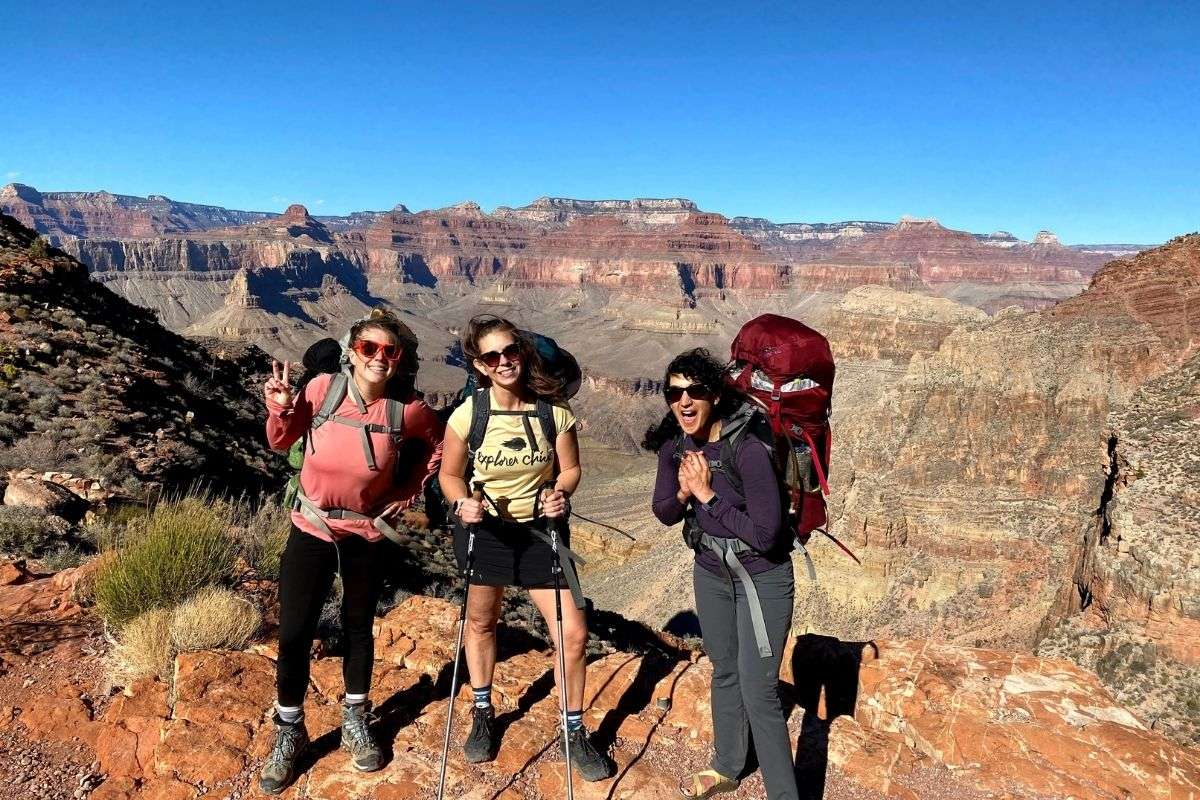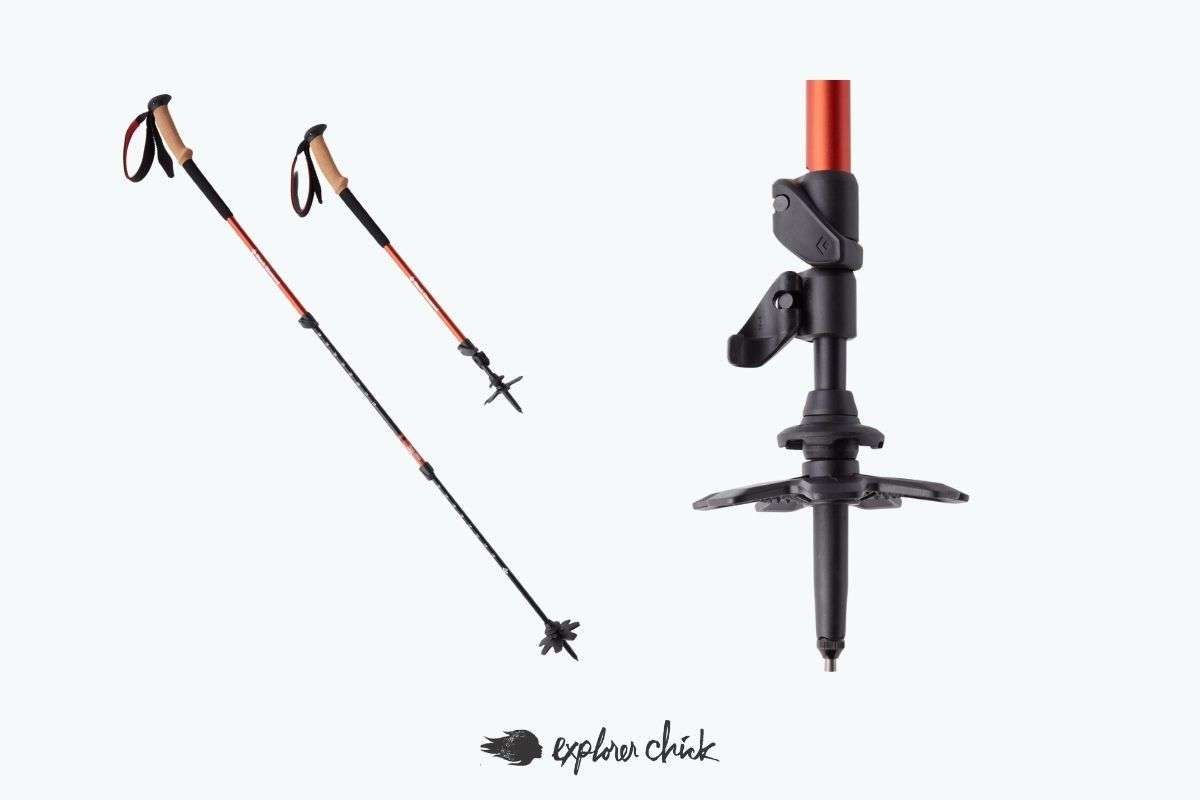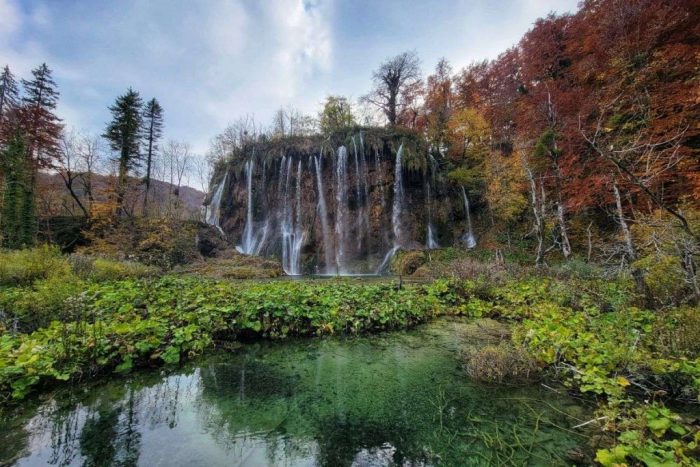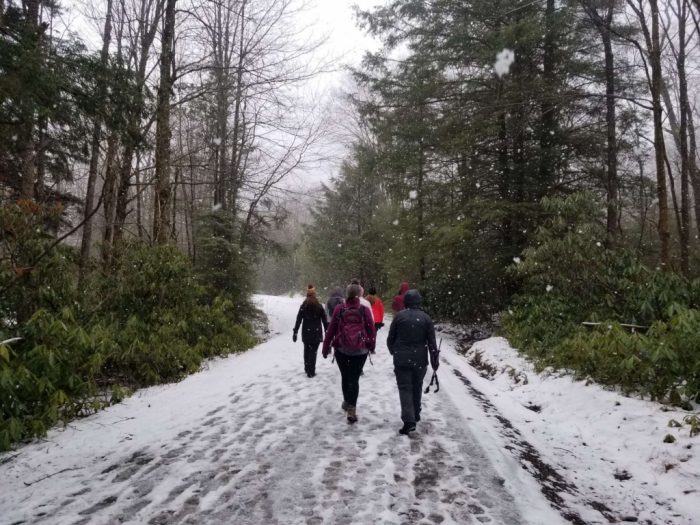How to Use Trekking Poles 101

Some hikers prefer to have their hands free on the trail, and no one likes to add unnecessary weight to their pack. But if you find your legs aching after hikes or you feel like you need more balance on tough terrain, it’s time to get yourself some trekking poles!
From local parks to backpacking the Grand Canyon, as you challenge yourself with more epic hikes, the right set of poles can make a BIG difference on your adventures.
Good quality poles can help you stand up straighter and improve posture while you’re trekking up the trail, and save your knees when you’re heading down.
Why Use Hiking Poles?

Hiking poles provide extra stability on tricky terrain where the ground is less stable, and reduce impact on your body while hiking on hard surfaces…
…As well as lots of other things. So we asked our girl gang in our Facebook group We Are Explorer Chick for more reasons to love hiking poles. Here’s what they had to say:
- Save your knees and ankles tremendously
- Scare away animals
- Easily brush snakes and small debris off trail
- Use them for tent poles to lighten the load backpacking
- Steady yourself on river crossings, streams, and creeks
- Better balance with a heavy pack
Someone even shared that trekking poles are great in case of an emergency as they can be used as a splint for broken bones. 🤯 We’ve found most hikers like the poles for going downhill, which is what Explorer Chick Jessica used them for last year on our Moab/Arches trip.

Jessica N
June 17, 2021My poles saved me on the Moab/Arches Explorer Chick trip I did back in April. The downhills especially, the poles helped me feel more secure on feet when my legs were tired.
Is it Better to Hike with One Walking Stick or Two Poles?
Hiking staffs may make you feel like you’re trekking Middle Earth, but using trekking poles in pairs is more helpful to you than hiking with one pole.
Many walkers swear by the single pole, but two poles on the ground gives you better balance and symmetrical support that one pole can’t. Using both poles also provides a more even upper body workout!
If you do use just one trekking pole, make sure you alternate sides on the downhill sections to prevent falls.
Getting the Right Trekking Pole Length
There is no one right length when it comes to trekking poles. It totally depends on the person!
In general, the top of the handle on your trekking poles should reach waist or hip length, and reach the top of your hand when your elbows are at a 90 degree angle.
If you’re over six feet tall, you’ll want poles with a longer maximum length (51 inches+). If you’re shorter than that, you’ll probably be fine with any size adjustable trekking poles.
5 Tips for How to Use Trekking Poles

Trekking poles become an extension of your badass hiking body, and make it easier to hike more miles with less impact stress causing aches and pains.
After you’ve given trekking poles a try on the trail, you’ll see why they’re worth carrying. We’re pretty sure your legs will thank you, too.
1. Walk Normally
Don’t stray from your typical walking technique when hiking with trekking poles.
Walk naturally when hiking with trekking poles and swing your arms as normal, and step forward with the opposite leg. When you swing your pole forward, it should hit the ground at the same time as the opposing foot.
Right pole, left foot. Left pole, right foot. Got it!
2. Use Your Wrist Strap
Lots of people misuse their wrist straps on their trekking poles or ignore them completely because they simply don’t know how to use them! When used correctly they can take considerable pressure off your hands, and make a huge difference in preventing aches and swelling.
Wrist straps should be tight enough to support the weight of your hands and keep you from having to grip your poles too tightly, but not so tight that it’s hard to get your hand out.
Put your hands through the bottoms of the strap loops on the left and right sides. Adjust the length by removing the tension block, pulling gently in a small upward motion on the straps until they fit snugly around your wrist, then replacing the block.
3. Lengthen the Poles When Walking Downhill
Adjusting your trekking poles correctly for the downhill side of hiking makes a HUGE difference on your descent. Making them a bit longer allows you to put more weight on the poles and less on your knees going down.
Hiking downhill puts more strain on your knees, and trekking poles help take off some of that weight.
If you’re heading down steep hills without adjustable poles, you can hold onto the top section of your poles to change the height of your grip a bit.
4. Shorten the Poles When Walking Uphill
Hilly terrain is a big part of hiking, and steep uphills also call for trekking pole adjustment.
When hiking uphill, you want the length of your trekking poles a little shorter to help you push off rather than pull up as you climb, with your poles falling behind your lead foot as you walk.
If you have fixed length poles, you can grab the lower section of the handle for some uphill assistance.
What to Look for When Buying Trekking Poles
- Pick a design that lets you store your walking poles parallel to each other and easily strap to your hiking pack.
- Trekking pole grips made of foam or cork grips don’t get slippery if your hands sweat, helping you keep a tight grip on your poles.
- Stick with snap locks or button locks. Telescoping poles that twist lock are easy to pull out too far by accident, and goodbye trekking poles.
- Look for trekking poles with fleece padding, or try Nordic walking poles to reduce friction if rubbing is a problem.
Here’s what one of our Explorer Chick Experts had to say:
“Titanium or carbon fiber, ultralight, and foam grips are things I look for. I also prefer the two speed lock adapters opposed to the simple lock mechanism (the kind that breaks into three sections and looks like nunchucks).”
Our pick? Something like these Black Diamond Trail Ergo Cork Trekking Poles.
These aluminum-based trekking poles come with Dual FlickLock adjustability, making them easy to adjust quickly and easily. They also break down to a convenient compactible size, which is perfect for packing away when not in use. With 171 positive reviews, it seems like most people love the adjustable grip. The poles come with a 15° corrective angle, making it perfect for people with arthritis or wrist pain.
*Disclosure: we independently choose all product recommendations. When you buy from product links in our posts, we may earn a small commission at no extra cost to you. This supports our ability to provide the best advice possible.
Use Your Hiking Poles with Explorer Chick!
Ready to put your phone on airplane mode in the name of ADVENTURE? Lace up your boots and hit the trail with Explorer Chick!
Our expert trail guides are ready to escort you on the hiking adventure or backpacking trip of your dreams, alongside other Explorer Chicks eager to get after the great outdoors.
Pack your 10 Essentials and join our community of adventure babes. Let’s get trekking!
Meet the Writer

April Brightman
April is an adventure lover and freelance writer based in New England, with a passion for public lands, wild places, and all things outdoors. She loves camping in any form and spends as many weekends as she can hiking New Hampshire’s highest peaks, or road-tripping with her sweet dog Marley. If not in the mountains, you can find her planning her next expedition or caring for one of her far-too-many-houseplants.
Favorite outdoor adventure: National Parks Hiking and Road Trips!
Read More Hiking Inspiration
- How To Keep Your Feet Warm During Winter Hikes
- Where to Find the Best Hikes in Belize
- The Ultimate 6-Day Croatia Hiking Itinerary, According to Hikers
- Our Ultimate Bucket List of the Best Hikes in Europe
- How Heavy Are Your Thoughts on Trail? Tips for Negative Thinking While Hiking
- Best Hiking Routes in Scotland for the Trailblazer
- What To Wear Hiking In Hot Weather
- How to Lace Boots For Hiking: 7 Pro Lacing Techniques
- How to Identify Poison Ivy (And How to Treat an Allergic Reaction)
- 5+ Amazing Things To Do While Visiting Slovenia









